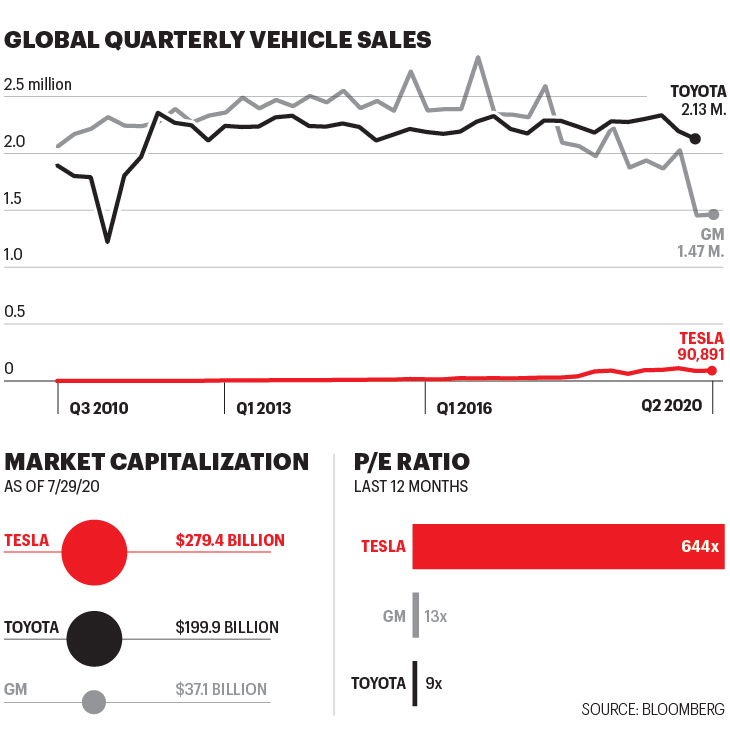
7月1日,特斯拉股價一路飆升,市值達到了驚人的2090億美元,讓這家誕生僅17年的電動汽車制造商坐上了全球車企市值的頭把交椅。而一個月后,特斯拉的市值更是達到了2790億美元,至此,雖然特斯拉的汽車銷量僅相當于通用汽車和福特兩大汽車巨頭的4%,但其市值卻已經超出底特律雙雄市值之和的四倍有余。取得如此成績,幾乎可以想象到馬斯克臉上滿意的笑容。

那么特斯拉的實際銷售量要達到多少才能滿足投資者的超額預期呢?為了回答這一問題,我們邀請了堅定看好特斯拉前景的摩根大通證券分析師喬·奧沙幫我們算了一筆賬。按照他的計算,特斯拉需要在2025年前實現250萬輛汽車的年銷量(即去年銷量的7倍),才能匹配自己的高估值。
這一數字是如何得出的呢?根據奧沙的估計,到2025年,全球電動汽車市場(特斯拉目前占有約三分之一的市場份額)的規模將達到600萬輛,約占全球汽車市場總規模的8%。他表示,如果低成本的中國制造電動汽車能夠占據全球大部分電動汽車市場,則特斯拉及其同行將獲得超過450萬輛的市場份額。奧沙認為,由于特斯拉的產品在競爭中處于優勢地位,其將從中分得最大的一塊蛋糕,即每年250萬輛的市場份額。
而要想滿足這么龐大的市場需求,特斯拉自然需要提升自己的產能。據特斯拉自己表示,到2021年年底,其上海工廠、加州弗里蒙特工廠及正在建設中的柏林工廠將具備每年交付110萬輛汽車的能力。而奧沙認為,“特斯拉即便不新設生產地點或制定具體增產計劃,增產到250萬輛也并非不可能”。
同時,奧沙表示,到2025年前,特斯拉的息稅折舊攤銷前利潤率(Ebitda)將達到20%(包括2%的股權激勵費用),而要達到這一數字,特斯拉以通用會計準則計算的毛利率需要保持在21%到25%之間。特斯拉最近一個季度包括工廠折舊、人工和材料成本在內的毛利率為21%,奧沙認為,隨著規模經濟發揮作用,特斯拉的毛利率水平將會有所提高。
他說,在考慮到風險和機會成本的前提下,使用20倍Ebitda乘數對所有這些因素進行計算可以得出,特斯拉的市值到2025年將達到4000億美元左右,而現在則應該為3000億美元左右。
“特斯拉可能會取得我們所設想的那種成功,也可能不會。” 奧沙說,“但從創立時的一文不名,到現在已經能夠每年售出50萬臺汽車,這樣一家快速發展的企業理應得到我們的重視。”(財富中文網)
本文另一版本刊載于《財富》雜志2020年8/9月刊。
譯者:Feb
7月1日,特斯拉股價一路飆升,市值達到了驚人的2090億美元,讓這家誕生僅17年的電動汽車制造商坐上了全球車企市值的頭把交椅。而一個月后,特斯拉的市值更是達到了2790億美元,至此,雖然特斯拉的汽車銷量僅相當于通用汽車和福特兩大汽車巨頭的4%,但其市值卻已經超出底特律雙雄市值之和的四倍有余。取得如此成績,幾乎可以想象到馬斯克臉上滿意的笑容。
那么特斯拉的實際銷售量要達到多少才能滿足投資者的超額預期呢?為了回答這一問題,我們邀請了堅定看好特斯拉前景的摩根大通證券分析師喬·奧沙幫我們算了一筆賬。按照他的計算,特斯拉需要在2025年前實現250萬輛汽車的年銷量(即去年銷量的7倍),才能匹配自己的高估值。
這一數字是如何得出的呢?根據奧沙的估計,到2025年,全球電動汽車市場(特斯拉目前占有約三分之一的市場份額)的規模將達到600萬輛,約占全球汽車市場總規模的8%。他表示,如果低成本的中國制造電動汽車能夠占據全球大部分電動汽車市場,則特斯拉及其同行將獲得超過450萬輛的市場份額。奧沙認為,由于特斯拉的產品在競爭中處于優勢地位,其將從中分得最大的一塊蛋糕,即每年250萬輛的市場份額。
而要想滿足這么龐大的市場需求,特斯拉自然需要提升自己的產能。據特斯拉自己表示,到2021年年底,其上海工廠、加州弗里蒙特工廠及正在建設中的柏林工廠將具備每年交付110萬輛汽車的能力。而奧沙認為,“特斯拉即便不新設生產地點或制定具體增產計劃,增產到250萬輛也并非不可能”。
同時,奧沙表示,到2025年前,特斯拉的息稅折舊攤銷前利潤率(Ebitda)將達到20%(包括2%的股權激勵費用),而要達到這一數字,特斯拉以通用會計準則計算的毛利率需要保持在21%到25%之間。特斯拉最近一個季度包括工廠折舊、人工和材料成本在內的毛利率為21%,奧沙認為,隨著規模經濟發揮作用,特斯拉的毛利率水平將會有所提高。
他說,在考慮到風險和機會成本的前提下,使用20倍Ebitda乘數對所有這些因素進行計算可以得出,特斯拉的市值到2025年將達到4000億美元左右,而現在則應該為3000億美元左右。
“特斯拉可能會取得我們所設想的那種成功,也可能不會。” 奧沙說,“但從創立時的一文不名,到現在已經能夠每年售出50萬臺汽車,這樣一家快速發展的企業理應得到我們的重視。”(財富中文網)
本文另一版本刊載于《財富》雜志2020年8/9月刊。
譯者:Feb
You could practically see Elon Musk smile.On July 1, after an impressive rally of its stock price, Tesla—the 17-year-old electric-car company for which Musk serves as CEO—became the world’s most valuable automaker, worth an eye-watering $209 billion.Barely a month later, it’s worth $279 billion—more than quadruple the combined value of American icons General Motors and Ford Motor, even though the California company sold just 4% of the vehicles the Detroit duo did last year.
How substantial must Tesla’s actual sales be to meet its investors’ outsize expectations? We asked Joe Osha, a JMP Securities analyst who specializes in energy and industrial tech—and a frequent Tesla bull—to show his math.By his calculation Tesla needs to sell 2.5 million vehicles per year, or almost seven times what it managed last year, by 2025 to justify its lofty valuation.
How did Osha arrive at that number? The analyst estimates that the global EV market—of which Tesla controls nearly a third today—will represent 6 million vehicles per year by 2025, or about 8% of the total global vehicle market.If a substantial share of the EV market goes to low-cost Chinese vehicles, he says, that leaves upwards of 4.5 million units to Tesla and its peers.Osha believes Tesla will capture the lion’s share of this portion—2.5 million per year—because “they’re ahead of the competition on product.”
Tesla, of course, requires the production capacity to support that kind of output.The automaker itself says its factories in Berlin (under construction), Shanghai, and Fremont, Calif., will support 1.1 million vehicles by the end of 2021.But Osha believes that “continued expansion to 2.5 million units is plausible even if we don’t have specific locations or plans” for new factories.
In the meantime, Osha says Tesla’s Ebitda margin will reach 20% (including stock-based compensation—about 2% for Tesla) by 2025, requiring a GAAP gross margin between 21% and 25%.The company’s current gross margin— 21% in its latest quarter—includes factory depreciation, labor, and materials; Osha believes it will improve with modest economies of scale.
Add it all up using the ubiquitous 20X Ebitda multiple, and Tesla will be an automaker worth somewhere in the ballparkof $400 billion in 2025, Osha says—or about $300 billion today, taking risk and opportunity cost into consideration.
“Tesla may or may not end up as successful as we think it will be,” he says.“But this company went from barely existing to selling half-a-million units a year.It should be valued like a growth company.”
A version of this article appears in the August/September 2020 issue of Fortune magazine.






